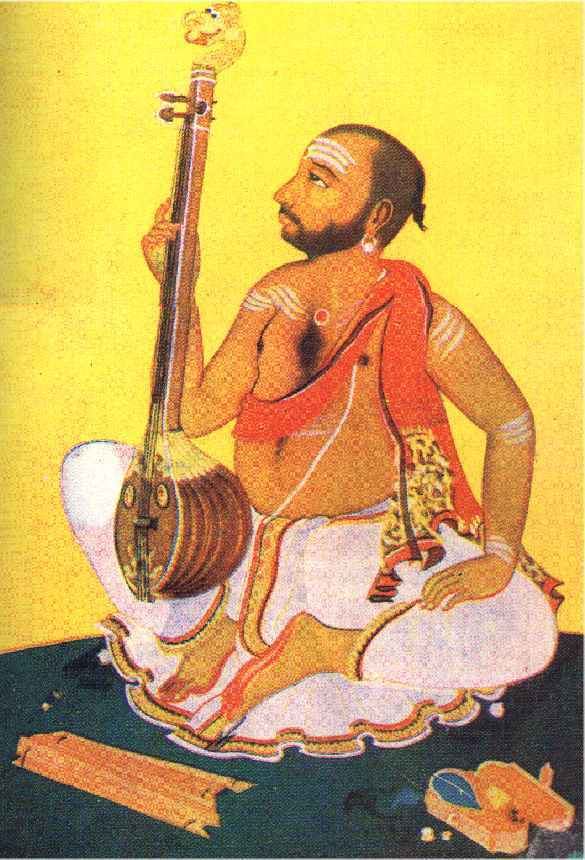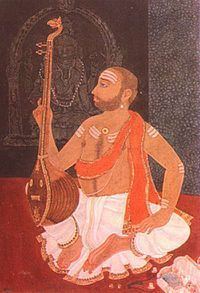Occupation Composer Role Composer Name Syama Sastri | Nationality Indian Children Subbaraya Sastri | |
 | ||
Books Evolution of Indian Polity Similar People Muthuswami Dikshitar, Tyagaraja, Swathi Thirunal Rama Va, Semmangudi Srinivasa Iyer, Papanasam Sivan | ||
Shyama Sastri Krithis | Audio Jukebox | Vocal | Carnatic | Bombay Jayashri
Syama Sastri (also commonly transliterated as Shyama Shastri) (1762–1827) is one of the most renowned composers of Carnatic music. He is the oldest among the Trinity of Carnatic music, Tyagaraja and Muthuswami Dikshitar being the other two.
Contents
- Shyama Sastri Krithis Audio Jukebox Vocal Carnatic Bombay Jayashri
- Kanakasaila punnagavarali syama sastri
- Career
- Descendants
- Compositions
- References

Kanakasaila punnagavarali syama sastri
Career

SYAMA SASTRI was born to Visvanathayya and Vengalakshmi on April 2, 1762. He was a Telugu speaking Brahmin known as Auttara Vadama. Visvanathayya and his forefathers were archakas in the temple of Goddess Bangaru Kamakshi, Thanjavur. Syama Sastri's actual name was Venkata Subrahmanya.

Although Śyāma Śastri did not compose as so many kr̥ti-s as his two prolific contemporaries, his compositions are still well known due to the literary value. It is said that he composed about three hundred pieces in all.
He did not have many disciples to propagate his compositions, nor was the printing press an easy convenience during his time. More importantly, the scholarly nature of his compositions was not appealing to the layperson, they needed to be studied to be savoured.In his compositions there is a perfect blend of Supreme Bhakti (Utmost Devotion), Manodharma Bhavam with adequate Sahityam, but very important all put into the cup of Absolute Talam (Rhythm).
He composed in Telugu and Sanskrit, mostly on goddess Kamakshi.
He composed kritis, varṇa(s) and svarajati(s) with the ankita or mudra (signature) Śyāma Krishna. He was probably the first to compose in a new form of the svarajati musical genre. Prior to this, the svarajati was primarily a dance form, and was close in structure to the dance Varṇaṃ (padavarṇaṃ).
His set of three famous svarajati(s) are intended to be sung in concert rather than danced, and are sometimes referred to as "Ratnatrayam" (Three jewels). They are in ragas Bhairavi, Yadukula kambhoji and Todi, and are called Kāmākṣhī Anudinamu, Kāmākṣhī Padayugamē, and Rāvē himagiri kumāri, respectively. The former two are set to Miśra Cāpu Tāḷa, while the third is set to Ādi Tāḷa.
He was known for his ability to compose in the most complex of Tāḷa(s). He was also known as "Talaprasthara Shyama Sastri" in music circles in those days. He was as adept in composing in rare ragas as he was in composing the popular ones. Anandabhairavi is considered to be his favourite raga. He was widely revered for his voice and singing ability during his time.
Descendants
Syama Sastri's son, the illustrious Subbaraya Sastri (1803–1862), had the unique privilege of learning under each of the trinity. His kritis with the signature 'Kumara' are known for encapsulating the entire structure of a raga in the space of a single composition. Syama Sastri's adopted grandson, Annasvami Shastri (1827–1900), was also a fine composer.
Compositions
The below sections mention some of his compositions.
